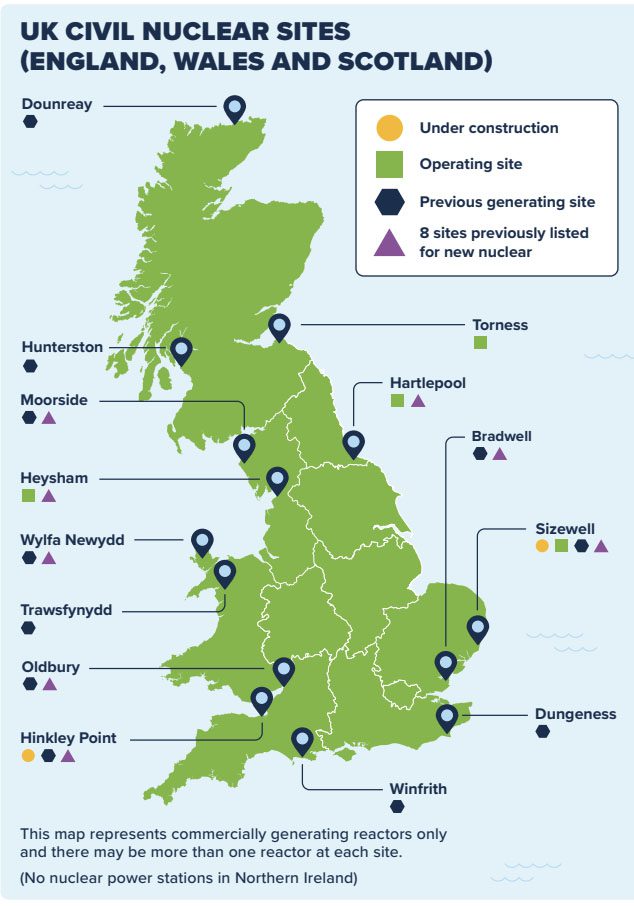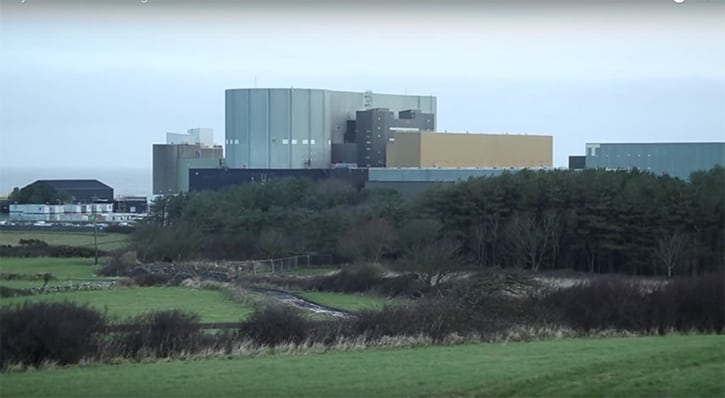UK Picks Wylfa in Wales as Preferred Site for New ‘Mega’ Nuclear Project
The UK government has picked Wylfa in Anglesey, North Wales, as its preferred site for the the country’s third large-scale nuclear power plant after Hinkley C in Somerset and Sizewell C in Suffolk.
The Department of Energy Security and Net Zero (DESNZ ) on May 22 unveiled the site as its “first choice” for the project that it said would bring the UK closer to its ambition to expand its current 6 GW nuclear capacity to 24 GW by 2050.
Great British Nuclear (GBN), the government’s March 2023-launched designated body to fast-track nuclear development, on March 7 bought land for new nuclear development from Japanese firm Hitachi at both Wylfa in Ynys Môn/Anglesey and Oldbury-on-Severn in Gloucestershire. While the sites have long been considered potential prospects for new nuclear, Hitachi formally dropped its plans to build a 2.7-GW ABWR plant at Wylfa in 2020.
GBN has noted that access to nuclear sites “is a critical factor in achieving [the UK’s] nuclear ambitions, which included deploying small modular reactors (SMRs) and exploring a further large-scale reactor project after Hinkley Point C and Sizewell C.”

A Historic Site Acquisition
GBN’s acquisition of the Wylfa and Oldbury sites marked the first time the government acquired land for new nuclear since the 1960s. Wylfa Nuclear Power Station began operation in 1971 as the UK’s largest plant running on Magnox reactors. It was initially set to permanently retire in 2010 but received extensions until it was finally shut down in December 2015. Oldbury, which began operation in 1967, like Wylfa, received extensions and eventually ceased operations in February 2012.

On Wednesday, the government suggested it had already launched talks with international energy firms to explore building the new power plant at Wylfa. While it provided no details about the plant’s technology or size, it suggested the UK’s future nuclear fleet would comprise “a mix of traditional large-scale power plants and small modular reactors, which can be rolled out more quickly and at scale.”
GBN is also vetting potential contenders from its SMR competition, a fast-track measure intended to result in a government contract within the next 10 months as part of a strategy to deliver operational SMRs by the mid-2030s. GBN in October 2023 shortlisted six nuclear designs from EDF, GE-Hitachi Nuclear Energy (GEH), Holtec Britain, NuScale Power, Rolls Royce SMR, and Westinghouse Electric Company UK.
In March, GBN allowed the six firms to access tender documentation, allowing them to bid for potentially multi-billion-pound technology development contracts. On Wednesday, the UK government suggested GBN could announce successful bidders for the SMR competition “by the end of this year.”
“Having agreed to purchase the Wylfa site earlier this year, GBN looks forward to working with the government on the market engagement programme for large scale gigawatt providers and also delivering this vital project in the years to come,” Gwen Parry-Jones, GBN CEO, said on Wednesday.
A Cautious Approach to Siting
Earlier this year, the UK government published a Civil Nuclear Roadmap, setting out a series of goals and actions that could enable the delivery of 3 GW to 7 GW of new nuclear every five years from 2030 to 2044. As POWER has reported, the roadmap suggests the country’s most prominent challenges rest on siting and land usage, regulations, workforce development, and financing and funding models—factors that have historically posed hurdles to nuclear development.
The UK government indicated that its selection of Wylfa was influenced not only by the economic benefits for the region but also by Wales’ longstanding nuclear history. Along with the two Magnox reactors at Wylfa, Wales hosted two Magnox reactors at Trawsfynydd, which ran between 1965 and 1991.
Secretary of State for Wales David TC Davies lauded the selection on Wednesday, highlighting the project’s significance as “the single biggest inward investment in Welsh history.” The news “promises to bring thousands of high-quality jobs to the local economy,” he said.
However, in a 2023 parliamentary report the Welsh Affairs Committee detailed the extensive preparatory work that began in 2022. While the work built on previous efforts related to the now-canceled Hitachi/Horizon ABWR development, the committee’s inquiry was comprehensive. It involved visits to the Vogtle expansion in Georgia and consultations with international nuclear experts, including Bechtel and Westinghouse, and wide engagement with a range of stakeholders, including industry experts, government officials, and local community representatives. Throughout the inquiry, the committee noted it received 38 pieces of written evidence, and it held five formal evidence sessions.
The UK’s nuclear support policies provided more leverage for the push, the committee noted. In addition, the Isle of Anglesey County Council and other local entities were actively involved, it said.
The committee, however, remained cautious, noting that it was told “that the finance model used for nuclear projects “is extremely important” and “can be a deal breaker.” Limitations of finance models led to the failure of projects, including Hitachi’s Wylfa Newydd project, it noted. However, the Nuclear Energy Financing Act of 2022 provides a new model of financing under the UK’s Regulated Asset Base (RAB) model, which will be pioneered for nuclear at Sizewell C, it noted.
“New nuclear power stations financed through this model are to be supported by a charge on electricity suppliers, which is expected to be passed on to consumers,” it said. “The UK Government, Sizewell C and the Nuclear Industry Association (NIA) said in evidence to us that using the RAB could reduce the overall cost of a large-scale nuclear project by £30 billion compared with the [Contracts for Difference (CfD), the currently available model],” it added. In addition, it noted: “Witnesses stated that the RAB model was more attractive to investors.”
Addressing Financial Risks Through Policy
For now, construction delays remain a prominent concern. The UK’s only nuclear project currently under construction—EDF’s 3.2-GW Hinkley Point C in Somerset, southwest England—is already fielding risks. A re-evaluation of schedule and costs unveiled in January suggested delays of up to three years, extending the in-service timeframe from 2027, as was recently anticipated, to 2031. Cost increases could push the project’s total price tag to between £40.98 billion ($52 billion) and £44.95 billion ($57 billion).
Still, construction at Hinkley C continues. On May 12, the project received the first of its eight 520-tonne steam generators. “Four will be placed in each reactor building, operating at an average temperature of 295C for at least 60 years. Their design, manufacturing and testing took six years,” EDF noted.
Sizewell C, a second 3.2-GW EPR nuclear project proposed in Suffolk, eastern England, secured a Development Consent Order (DCO) in January, opening the path to formal construction. The UK government’s Civil Nuclear Roadmap, launched in January 2024, suggests that the UK will make a final investment decision (FID) on the power plant by the end of the current Parliament (which culminates in December 2024). If approved, Sizewell C could begin operations in the mid-2030s.
The government in November 2022 notably took on a 50% stake alongside EDF and later launched an equity raise process to attract private investors into the project. However, earlier in May, the UK Subsidy Advice Unit (SAU) accepted a request from the DESNZ and the UK Infrastructure Bank to produce a report evaluating a “subsidy scheme.” The subsidy scheme could support the construction, operation, and decommissioning of the proposed two-unit plant. If approved, it would begin at the FID, which is targeted at the end of the year.
The package of measures (separate from the SZC Devex Scheme, which is designed to fund development expenditure up until FID) is designed to attract private investment into the project alongside EDF and the government, DESNZ said. It will be backed by the Nuclear RAB financing model and is expected to be finalized based on market feedback from ongoing equity and debt fundraising efforts.
According to DESNZ, the package will include: allowed revenue through Nuclear RAB funding to provide returns and cover operating expenses during construction, commissioning, and operation; a government support package to mitigate specific high-impact, low-probability risks; and government debt and equity finance.
—Sonal Patel is a POWER senior editor (@sonalcpatel, @POWERmagazine).